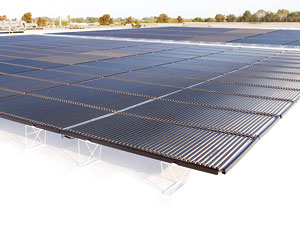Like time and money, the space on the rooftops of public and commercial buildings is a finite resource. Now, a curvy, new solar cell offers building owners and contractors an opportunity to make the most of all three. The system consists of dozens of hermetically sealed glass tubes containing a cylindrical core of thin-film photovoltaic material arranged in a 3.5-ft x 5-ft rectangular aluminum framework to create panels specifically designed for optimal performance on low-slope rooftops.


Introduced last July by Fremont, Calif.-based Solyndra Inc., the cells are designed to catch more light as it hits rooftops from many different directions. “The cylindrical shape allows us to take full advantage of all the sunlight that strikes the roof,” says Kelly Truman, Solyndra’s vice president of sales, marketing and business development. “Because 360 degrees of the tube’s core is covered in photovoltaic material, it can absorb both direct sunlight and the light from more diffuse sources, including light that’s reflected off the roof’s surface.”
Just as the tubular design helps make the most of available sunlight, the panels are equally efficient in terms of space. “Unlike traditional, flat solar panels that have to be spaced far enough apart that their shadows don’t overlap, ours are designed be placed very close together,” Truman says. “This allows a contractor to cover more of the available surface, which in turn helps a building owner get more electricity out of the same amount of rooftop.”
Aside from the cost of the hardware, which PV experts say typically runs about $7,000 per kW, installation is the biggest expense on a solar project. The new panels also offer an advantage in this regard. “The five-person crew that installed the 50-kW system on the roof of our Tooele, Utah, plant last November installed 150 Solyndra panels in about five hours,” says Dick Gillenwater, manager of advanced products for Carlisle Construction Materials. “To put that in perspective, the two guys on the crew who had experience installing photovoltaic systems told me it would have taken them about three days to do a conventional, flat solar-panel installation of that size.”

Much of the increased productivity can be traced back to the panel’s low profile. Unlike flat panels, air moves around the Solyndra tubes, allowing them to stay put in winds up to 130 mph. They also do not need to be installed at a precise tilt and compass orientation: Company tests confirm that mounting the panels with the tubes running at a 45° angle to the direction of the sun results in only a 1% drop in power output.
While solar installations have had limited acceptance in the U.S., Truman thinks that may change with some of the green initiatives that have been endorsed by the Obama administration. “The U.S. has so much more solar energy available compared to other parts of the world,” says Truman. “Even if we could take advantage of just a fraction of the 30-billion sq ft of low-slope rooftops in the U.S., that would go a long way toward make the most of what is one of this country’s most underutilized resources.”


Post a comment to this article
Report Abusive Comment